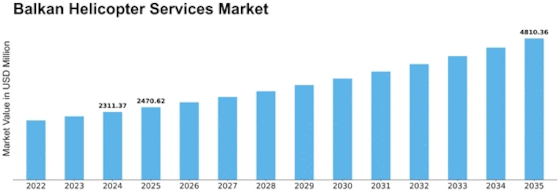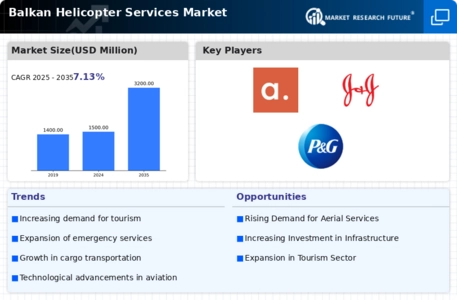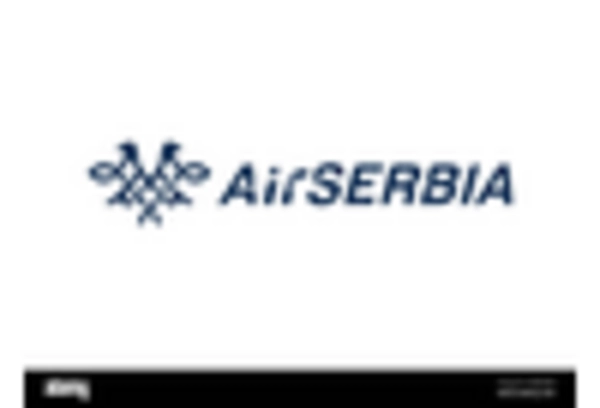Balkan Helicopter Services Size
Balkan Helicopter Services Market Growth Projections and Opportunities
The Balkans helicopter services market is influenced by several key factors that shape its growth and development. One significant factor is the region's geographical characteristics, which include rugged terrain, remote areas, and dispersed populations. These geographical features create challenges for transportation infrastructure, particularly in providing efficient and timely access to remote or hard-to-reach locations. Helicopters offer a flexible and versatile solution for addressing these challenges, providing point-to-point transportation, medical evacuation, search and rescue, and other critical services to communities, businesses, and government agencies across the Balkans. As a result, there is a growing demand for helicopter services in the region to support various industries, including tourism, energy, agriculture, construction, and emergency response.
Moreover, economic factors drive market demand for helicopter services in the Balkans. The region's economy is characterized by diverse industries, including tourism, manufacturing, agriculture, and natural resources extraction. Helicopters play a crucial role in supporting these industries by providing essential transportation and logistical support for personnel, equipment, and supplies. In the tourism sector, helicopters offer scenic flights, aerial tours, and VIP transportation services to explore the region's natural beauty, historical landmarks, and cultural attractions. Additionally, in the energy sector, helicopters are used for aerial surveys, infrastructure inspections, and personnel transport to support oil and gas exploration, renewable energy projects, and power transmission networks. Moreover, in the agriculture sector, helicopters are employed for crop spraying, aerial seeding, and frost protection, enhancing productivity and efficiency for farmers and agribusinesses.
Furthermore, regulatory frameworks and safety standards significantly influence market dynamics in the Balkans helicopter services market. Aviation authorities and regulatory agencies in the region impose strict regulations and certification requirements that govern helicopter operations, safety standards, and pilot qualifications. Compliance with these regulations is essential to ensure the safety, reliability, and airworthiness of helicopter operations and to mitigate risks to passengers, crew, and the environment. Additionally, adherence to international safety standards, such as those outlined by the International Civil Aviation Organization (ICAO) and the European Aviation Safety Agency (EASA), is critical for maintaining operational excellence, customer confidence, and regulatory compliance in the Balkans helicopter services market.
Moreover, market demand for helicopter services in the Balkans is driven by factors such as infrastructure development, emergency response requirements, and tourism trends. As countries in the region invest in infrastructure development projects, such as road construction, energy pipelines, and telecommunications networks, there is a growing demand for helicopter services to support project logistics, personnel transport, and aerial surveys. Additionally, the region's vulnerability to natural disasters, such as earthquakes, floods, and wildfires, underscores the importance of helicopter services for emergency response, disaster relief, and humanitarian assistance efforts. Helicopters provide rapid access to affected areas, conduct aerial reconnaissance, and deliver critical supplies, medical aid, and personnel to support disaster response operations.
Furthermore, market factors such as technological advancements, fleet modernization, and industry consolidation influence market dynamics in the Balkans helicopter services market. Helicopter operators in the region are investing in fleet modernization programs to upgrade their aircraft with the latest technologies, equipment, and safety features to enhance operational efficiency, reliability, and customer satisfaction. Additionally, advancements in helicopter design, propulsion systems, avionics, and navigation technologies enable operators to offer enhanced capabilities, such as increased range, payload capacity, and mission flexibility, to meet diverse customer needs and operational requirements. Moreover, industry consolidation and strategic partnerships among helicopter operators, maintenance providers, and leasing companies contribute to market growth, economies of scale, and operational synergies in the Balkans helicopter services market.
Moreover, market demand for helicopter services in the Balkans is influenced by external factors, such as geopolitical tensions, security threats, and tourism trends. The region's geopolitical landscape is characterized by historical conflicts, ethnic tensions, and unresolved territorial disputes, which pose challenges for transportation infrastructure and access to certain areas. Helicopter services offer a safe and reliable means of transportation for diplomatic missions, humanitarian aid, and security operations in the region. Additionally, tourism trends, such as adventure travel, ecotourism, and luxury experiences, drive demand for helicopter tours, charters, and transportation services to explore the Balkans' diverse landscapes, cultural heritage, and natural attractions. Helicopters offer a unique and memorable way to experience the region's beauty, history, and hospitality, attracting visitors from around the world and contributing to the growth of the Balkans helicopter services market.


















Leave a Comment